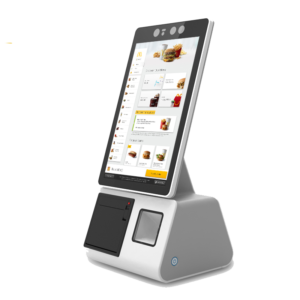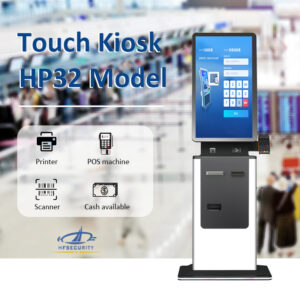Өнеркәсіптік биометриялық дүңгіршектер машина өндірушісі
Биометриялық дүңгіршектер машинасының өндірушісі
Қауіпсіздік пен тиімділікті арттырғысы келетін бизнес үшін HFSecurity биометриялық дүңгіршегі тамаша шешім болып табылады. Біздің дүңгіршектер саусақ ізі сканерлері, ирис сканерлері және бет-әлпетті тану сияқты әртүрлі биометриялық технологиялармен жұмыс істеуге арналған. Пайдалануға оңай бағдарламалық құралдың көмегімен сіз бірнеше рет басу арқылы пайдаланушыларды қосуға немесе жоюға болады. Біздің дүңгіршектеріміз ауыр пайдалануға төтеп беру үшін жасалғандықтан, олар қозғалыс көп аймақтарға өте ыңғайлы. Ғимаратқа кіруді қамтамасыз етуді немесе қызметкерлердің уақытын есепке алуды жеңілдетуді қалайсыз ба, HFSecurity биометриялық дүңгіршегі дұрыс таңдау болып табылады. Біздің өнімдеріміз бен қызметтеріміз туралы көбірек білу үшін бүгін бізге хабарласыңыз.
Өнеркәсіптік биометриялық шешім жеткізушісі
Биометриялық дүңгіршек машинасы туралы білуіңіз керек барлық нәрсе
Биометриялық дүңгіршек - пайдаланушының аутентификациясы үшін биометриялық деректерді пайдаланатын өзіне-өзі қызмет көрсететін коиск машинасы. Биометриялық деректер әр адамға бірегей және саусақ іздерін, ирис сканерін немесе бет-әлпетті тануды қамтуы мүмкін. Биометриялық дүңгіршектер әдетте үкіметтік ғимараттар немесе әуежайдың қауіпсіздік бақылау бекеттері сияқты жоғары қауіпсіздік орталарында қолданылады. Оларды кеңсе ғимараттары мен сауда орталықтары сияқты көптеген қоғамдық орындарда да кездестіруге болады. Биометриялық дүңгіршекті пайдаланған кезде пайдаланушылар алдымен аты-жөні мен туған күні сияқты жеке мәліметтерін көрсетуі керек. Содан кейін олар биометриялық деректерін жазу үшін қолын немесе саусағын сенсорға қояды. Деректер түсірілгеннен кейін олар киосктің дерекқорында сақталған жазбалармен салыстырылады. Сәйкестік бар болса, пайдаланушы аутентификацияланады және қалаған қызметтерге рұқсат береді. Биометриялық дүңгіршектер нысандарды қорғаудың және жеке басын ұрлаудан қорғаудың тиімді әдісі болып табылады. Олар пайдаланушылар үшін де ыңғайлы, өйткені олар жеке куәліктерді алып жүру немесе құпия сөздерді есте сақтау қажеттілігін болдырмайды.

Биометриялық дүңгіршектің мақсаты
Биометриялық дүңгіршектер қауіпсіздікті жақсарту және процестерді жеңілдету тәсілі ретінде барған сайын танымал бола бастады. Міне, биометриялық дүңгіршектер үшін ең көп қолданылатын кейбіреулер:
-Уақыт және сабаққа қатысу: Биометриялық дүңгіршектер жұмыс уақытын бақылауды жеңілдете отырып, жұмысқа кіру және шығу үшін пайдаланылуы мүмкін.
-Қауіпсіздік: саусақ ізі немесе басқа биометриялық деректер арқылы жеке басын растау арқылы биометриялық дүңгіршектер ғимараттарға немесе шектеулі аймақтарға рұқсатсыз кіруді болдырмауға көмектеседі.
-Қолжетімділікті бақылау: Биометриялық дүңгіршектер жеке тұлғаның жеке басын ескере отырып, белгілі бір аймақтарға кіруге рұқсат беру немесе тыйым салу үшін пайдаланылуы мүмкін. Бұл көбінесе қауіпсіздік жүйелерімен бірге қолданылады.
-Төлемдер: Биометриялық дүңгіршектерді несие немесе дебеттік карталарды пайдалана отырып, қолма-қол ақшасыз төлемдерді жүзеге асыру үшін пайдалануға болады. Бұл алаяқтықты азайту тәсілі ретінде танымал бола түсуде.
- Тұтынушыларға қызмет көрсету: биометриялық дүңгіршектерді тұтынушыларға қажетті ақпаратты табуға немесе тіпті тапсырыс беруге көмектесу үшін пайдалануға болады. Бұл күту уақытын қысқартуға және тұтынушылардың қанағаттануын жақсартуға көмектеседі.
адамның саусақ ізінің, иристің немесе басқа физикалық сипаттаманың суретін түсіреді
Басқару тақтасы құрылғының параметрлерін және кіріс деректерін басқару үшін пайдаланылады
Қуат көзі құрылғының дұрыс жұмыс істеуі үшін жеткілікті қуатқа ие болуын қамтамасыз етеді
Дисплей экраны пайдаланушыға ақпаратты береді
Бағдарлама биометриялық деректерді өңдеу және оны бар жазбалармен сәйкестендіру үшін пайдаланылады
Биометриялық құрылғы – жеке тұлғаларды анықтау үшін саусақ ізі немесе ирис сканері сияқты физикалық сипаттамаларды пайдаланатын қауіпсіздік жүйесі. Біреу биометриялық құрылғыны пайдаланғысы келсе, алдымен аты-жөні мен туған күні сияқты кейбір жеке ақпаратты ұсынуы керек. Бұл ақпарат жеке тұлға үшін бірегей профиль жасау үшін пайдаланылады. Содан кейін адам құрылғыны пайдалануға барған кезде олардан биометриялық ақпаратын беру сұралады. Құрылғы жеке тұлғаның профиліндегі ақпаратты олар берген ақпаратпен салыстырады. Егер екеуі сәйкес келсе, адамға құрылғыға кіруге рұқсат беріледі. Биометриялық құрылғылар барған сайын танымал болып келеді, өйткені олар құрылғылар мен деректерді қорғаудың қауіпсіз әдісін ұсынады.
Олар саусақ іздері, ирис үлгілері немесе бет ерекшеліктері сияқты бірегей физикалық сипаттамалары негізінде адамдарды анықтай алады. Бұл рұқсат етілмеген тұлғалардың ғимараттарға немесе басқа қорғалған аумақтарға қол жеткізуін қиындатады.
Олар уәкілетті тұлғаларға күрделі құпия сөздерді есте сақтамай немесе бірнеше кілттерді алып жүрмей-ақ ғимараттарға немесе басқа қорғалған аймақтарға жылдам және оңай қол жеткізуге мүмкіндік береді.
Олар рұқсат етілмеген адамдардың ғимараттарға немесе басқа қорғалған аймақтарға кіруіне жол бермейді, олардан саусақ іздері, ирис үлгілері немесе бет ерекшеліктері сияқты белгілі бір физикалық сипаттамаларды беруді талап етеді.
Мысалы, бөлшек саудада пайдалануға арналған дүңгіршек денсаулық сақтау мекемесінде пайдалануға арналған талаптардан басқаша болады.
Оларды интернеттен, дүкендерден немесе өндіруші арқылы табуға болады . Егер сіз онлайн сатып алсаңыз, беделді сатушыдан сатып алғаныңызға көз жеткізгіңіз келеді.
Дүкенде сатып алсаңыз , сканерді жеке көріп, ол туралы сұрақтар қоя аласыз.
Ақырында, егер сіз өндіруші арқылы сатып алсаңыз , сіз жоғары сапалы өнімді алатыныңызға сенімді бола аласыз
Ең көп таралған әдістер - саусақ ізі, ирис және бет-әлпетті тану, бірақ қолданбаға байланысты басқалары қажет болуы мүмкін.
Мысалы, ашық ауада пайдалануға арналған дүңгіршек ауа райына төзімді болуы керек
дүңгіршектің және онымен байланысты бағдарламалық және аппараттық құралдардың құнын ескеру маңызды. Биометриялық дүңгіршектердің бағасы бірнеше жүз доллардан бірнеше мыңға дейін өзгеруі мүмкін, сондықтан бюджетке сәйкес келетін модельді таңдау маңызды.







